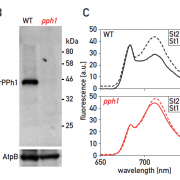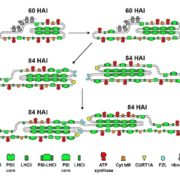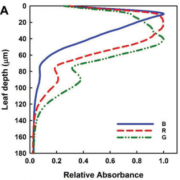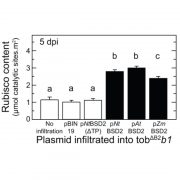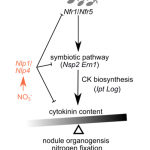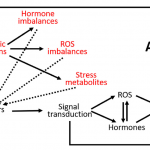Alternative CAM and water-saving flux modes into C3 leaf metabolic model (Plant Cell)
 Crassulacean acid metabolism (CAM) is a photosynthetic adaptation pathway in arid environments to minimize water loss by opening the stomata at night, when the temperature and therefore water loss due to transpiration is lower. Carbon dioxide is initially fixed at night and stored in the vacuole. Engineering CAM photosynthesis into a C3 crop plant is of a great interest to maximize the water-use efficiency for plants grown in hot or arid climates. Tӧpfer et al. constructed a time-resolved, large-scale metabolic leaf model and coupled it to a gas-exchange model to investigate the effect of temperature and relative humidity on plant metabolism. They found the vacuolar storage capacity of the leaf is a major determinant of the extent of CAM, and without a higher vacuole-to-cytoplasm ratio it is unlikely that a full CAM cycle can be introduced into a C3 leaf. Their model also identified an alternative CAM model comprising the reversibility of isocitrate dehydrogenase in mitochondria that is potentially beneficial to fixing carbon at night. More significantly, the water-saving effect of the CAM model is simulated across a large range of environments that are normally faced by crop plants in temperate and hot climates. This study sheds light on improving the water-use efficiency of C3 plants by introducing alternative CAM metabolism under wide range of environmental conditions. (Summary by Min May Wong @wongminmay) Plant Cell 10.1105/tpc.20.00132
Crassulacean acid metabolism (CAM) is a photosynthetic adaptation pathway in arid environments to minimize water loss by opening the stomata at night, when the temperature and therefore water loss due to transpiration is lower. Carbon dioxide is initially fixed at night and stored in the vacuole. Engineering CAM photosynthesis into a C3 crop plant is of a great interest to maximize the water-use efficiency for plants grown in hot or arid climates. Tӧpfer et al. constructed a time-resolved, large-scale metabolic leaf model and coupled it to a gas-exchange model to investigate the effect of temperature and relative humidity on plant metabolism. They found the vacuolar storage capacity of the leaf is a major determinant of the extent of CAM, and without a higher vacuole-to-cytoplasm ratio it is unlikely that a full CAM cycle can be introduced into a C3 leaf. Their model also identified an alternative CAM model comprising the reversibility of isocitrate dehydrogenase in mitochondria that is potentially beneficial to fixing carbon at night. More significantly, the water-saving effect of the CAM model is simulated across a large range of environments that are normally faced by crop plants in temperate and hot climates. This study sheds light on improving the water-use efficiency of C3 plants by introducing alternative CAM metabolism under wide range of environmental conditions. (Summary by Min May Wong @wongminmay) Plant Cell 10.1105/tpc.20.00132


